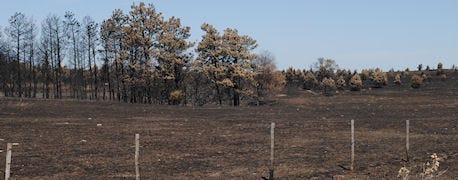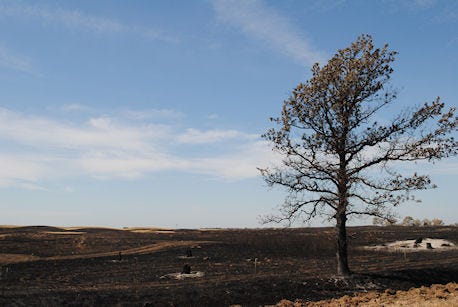
Ron and Sandra Heerten, who farm east of Norden, were evacuated twice from their home during recent wildfires that consumed thousands of acres in the region. The entire family was active, along with everyone else in the area, in helping neighbors and fighting the fire.
Not surprisingly for a busy farm family, among the personal items they grabbed when they evacuated were their children's 4-H projects that were being prepared for upcoming 4-H achievement days.

Fire Blackens 117 Square Miles of Rangeland
"It's amazing what stuff you grab in a case like that," says Sandra Heerten. "I grabbed our daughters' 4-H projects when we left." The fires came to within a mile of their farm, burning grass center pivot corners, before the wind switched to the north and sent the flames away from their home.
What started as a lightning strike on July 20 to the parched grassland and forests in northern Brown County, resulted in the burning of an estimated 117 square miles along the Niobrara River Valley in Brown, Keya Paha and Cherry counties. The main fire, known as the Fairfield Creek fire, and two other fires that also ignited from lightning known as Wentworth and Hall fires that raged 20 miles to the east, kept local farmers like the Heertens, ranchers and volunteers, over 300 firefighters and five heavy-lift helicopters hauling water, busy for eleven days. The fires combined as some of the most tragic wildfires to rage in Nebraska in recent memory.

Fire Blackens 117 Square Miles of Rangeland
"It's a one-two punch," says University of Nebraska Extension educator, Dennis Bauer, who covers Brown, Keya Paha and Rock counties. "For ranchers that were short of feed to start with because of the drought, what little forage that was left, is now black. We're really scrambling to figure out what we are going to feed the cows in the fall and winter because of the drought and now, the fire."
The fires destroyed drought-stricken grassland, hay piles, miles of fencing and at least 14 homes and 17 other structures, and cost around $3 million to fight. The fire burned through Norden, destroying nearly everything but the dance hall, county fair exhibit hall and arena.
Hampered by high winds, low humidity and midday temperatures soaring to105 degrees, firefighters battled heat exhaustion and unpredictable flames that jumped the Niobrara River several times.
"Everyone has done a tremendous job" in fighting the fire and dealing with the aftermath, Bauer says. "Everybody pitches in. That's what makes Nebraska such a great place to live. Everybody helps everybody in need."
Heerten says, "We're still watchful for more fires, at least until it rains. The volunteers are still watching and are on active duty."
You can help the ranchers and residents in the fire-stricken region through monetary donations that will assist with the cost of the fire, including fencing, hay for animals, fire department expenses and personal needs for families impacted. Make checks out to the NCDC Fire Relief Fund and mail them to University of Nebraska BKR Extension office, 148 W. 4th St., Ainsworth. Donations of wire and posts can be dropped off at Farmers and Ranchers Co-op in Ainsworth and Springview. You can also make donations through the Ainsworth Fire Department, c/o Fairfield Creek Fire Donation, P.O. Box 425, Ainsworth, NE 69210.
About the Author(s)
You May Also Like






